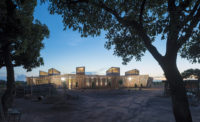Dano, Burkina Faso
In 2001, while still a student at Dano, Burkina Faso the Berlin Technical University, Diébédo Francis Kéré completed his first project: a small primary school in Gando, his native village in Burkina Faso. An exemplary piece of architecture, built in a poor country rife with illiteracy and unemployment, the Gando project earned Kéré a coveted Aga Khan Award in 2004 and helped put the young West African architect on the map.
Kéré now runs an eight-employee practice in Berlin and works worldwide. Designing sustainable buildings for Africa, however, remains his primary focus. His nonprofit organization, Schulbausteine für Gando, or School Building Blocks for Gando, helps raise money for his work. “My motto,” he says, “is help to self-help.”
In 2006, Kéré was hired by the Dreyer Foundation, a Munich-based philanthropic group that finances projects in Africa, to design a new building for a secondary school in Dano, a small Burkinabè town. The building was to house roughly 180 students. As with his Gando project, Kéré wanted to create a naturally ventilated building that responded to the region’s stifling heat, yet also was sturdy enough to endure its four-month rainy season. He also was determined to utilize local materials and labor — a key component of his design philosophy.
For the flat site dotted with trees, Kéré created a single-story L-shaped building that is oriented east to west, to mitigate heat gain. Its rectangular volume is partitioned into four 615-square-foot units — three are classrooms, while the fourth is an open area with sunken, oval-shaped seating. The adjoining 615-square-foot cubic volume is reserved for teachers and the school director.
The building includes several innovative features that reveal Kéré’s ingenuity. The load-bearing masonry walls, for instance, are made of laterite, an iron-rich soil found in the area that hardens when exposed to air. Villagers shaped the red bricks with basic tools. “This is very important — they don’t need to buy a new tool to do this building,” emphasizes Kéré. In constructing the walls, the architect opted to use less mortar than is typically applied in bricklaying. His goal: to “let the material be seen like it is,” while also boosting the walls’ strength.
To protect the building from the elements, Kéré developed an undulating, corrugated tin roof that hovers several feet above the building and is supported by an elegant truss system made of common rebar. Aesthetically striking, the roof’s wavelike form also has a pragmatic function: Water is channeled into the folds and funneled off the roof, away from the building. (Money permitting, Kéré hopes to someday add a catchment basin.) Moreover, the roof’s deep overhangs shade the structure, ensuring cooler temperatures indoors.
Indeed, creating a comfortable learning environment was important to Kéré, who spent his childhood school days in Burkina Faso. (At age 19, he received a scholarship to study carpentry in Germany and later earned his architecture degree there.) Kéré has vivid memories of pupils crammed into sweltering classrooms with low ceilings and little air circulation. “I could touch the roof,” he says. “It was very hot inside because the air didn’t move.” For the Dano project, he incorporated two features that promote natural ventilation. First, the ceiling, made of concrete and brick, is a series of inverted barrel vaults, each separated by 8-inch slots that allow hot air to escape. Second, the rooms have glassless windows covered by collapsible tin shutters called lamellas. “When you open these,” Kéré says, “the air is flowing.”
Completed in 2007 at a cost of about $80,000, the Dano School received critical acclaim and helped Kéré garner several more prestigious accolades, including the 2009 Global Award for Sustainable Architecture and the 2010 BSI Swiss Architectural Award (a $100,000 prize). For the architect, however, the real success was the community’s engagement in the project. At times, half of the village was on-site, working on the building. “They are really proud,” Kéré says. “I didn’t say wait and see what I do. We did it together. It’s a process with the people.”










Post a comment to this article
Report Abusive Comment